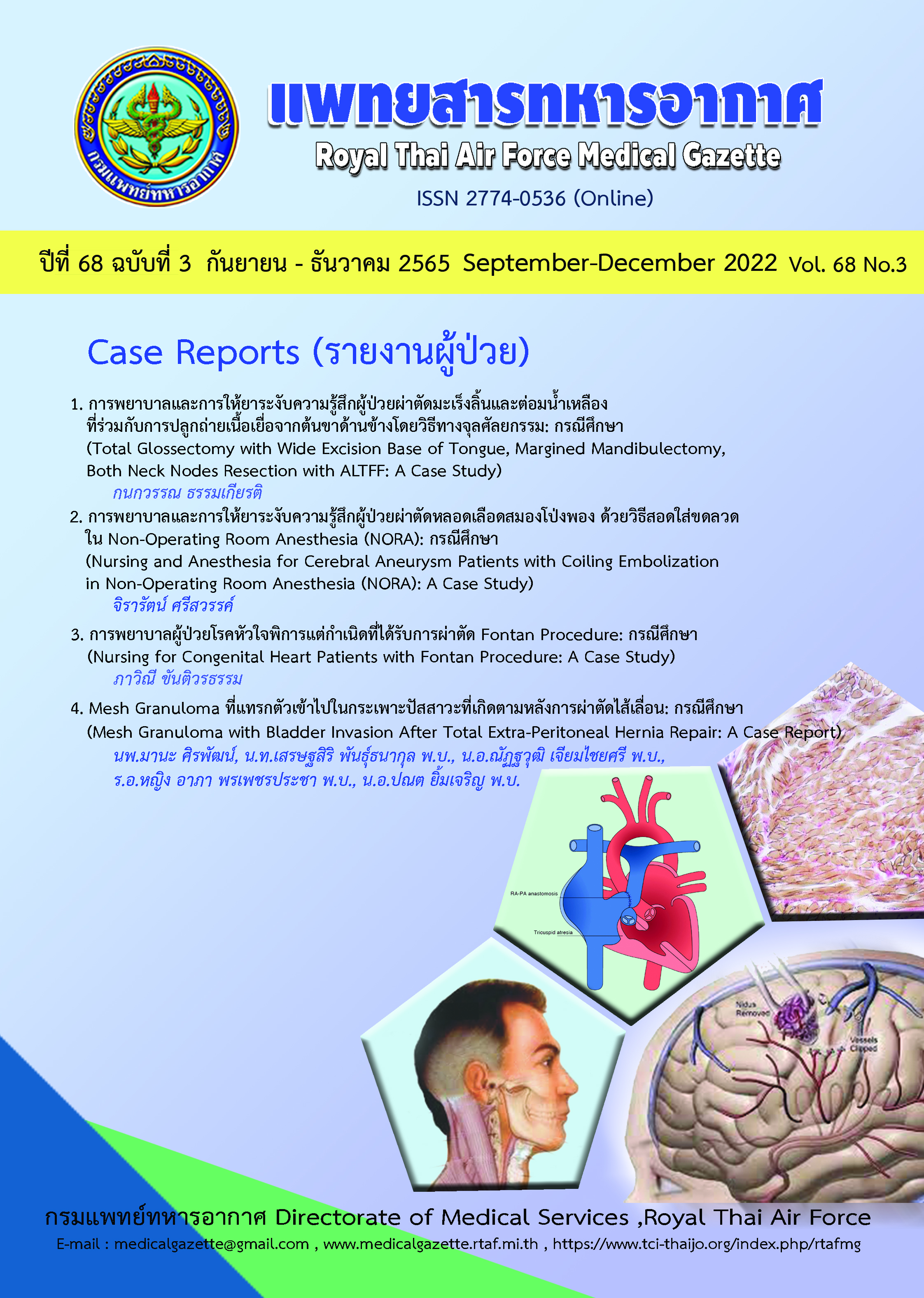Nursing and Anesthesia for Cerebral Aneurysm Patients with Coiling Embolization in Non-Operating Room Anesthesia (NORA): Case Study
Main Article Content
Abstract
Objective : To study, analyze problems and to develop a nursing practice guideline for cerebrovascular aneurysm patients receiving anesthesia for Coiling Embolization aneurysm.
Methods: A case study of purposive selection in cerebrovascular aneurysm patients receiving anesthesia during Coiling Embolization aneurysm surgery. admitted to Rajavithi Hospital Data was collection from medical records, physical examination, history taking from patients and relatives, problem finding, nursing diagnosis according to the 11 concepts of Gordon's Health Model. in conjunction with the application of Orem's nursing theory1, planning and nursing practice according to nursing diagnoses Summary and evaluation of nursing outcomes.
Results: A 48-year-old Thai female patient came to the hospital with headache, nausea and vomiting 4 hours before her visit. computerized tomography of the brain, brain hemorrhage and cerebral aneurysm were found. At first, the patient was good conscious, was in grade 5 on both limbs, and had a headache. The pain score was 6 points, accompanied by convulsions and high blood pressure. received anti-seizure medication and antihypertensive medication Doctors consider planning to place stents around the cerebral aneurysm. Provided general anesthesia with endotracheal intubation, administered balance technics anesthesia, arranged in a supine position. During the procedure, drugs were given to reduce blood pressure when stimulated to prevent the rupture of cerebral aneurysms. successful completion of the procedure . Extubation was removed and sent to the neurosurgical intensive care unit. Follow-up visit after surgery in patients with headache after receiving painkillers, the symptoms improved. Pain score 3 points, no nausea, vomiting, hospitalized for 14 days, discharged home.
Conclusion: Anesthesia for Coiling Embolization of cerebrovascular aneurysm surgery according to the standards for helping the procedure to be successful Therefore, it should be developed and used as a guideline for nursing practice in the future.
Article Details

This work is licensed under a Creative Commons Attribution-NonCommercial-NoDerivatives 4.0 International License.
บทความที่ได้รับการตีพิมพฺเป็นลิขสิทธิ์ของวารสาร
References
ฟาริดา อิบราฮิม.ปฏิบัติการพยาบาลตามกรอบทฤษฎีการพยาบาล :บริษัท สามเจริญพาณิชย์;2546
Andrew J.Ringer et al., Intracranial aneurysms. New York: Academic Press; 2018
Ayling OG, Ibrahim GM, Drake B, Torner JC, Macdonald RL.. Operative complications and differences in outcome after clipping and coiling of ruptured intracranial aneurysms. J Neurosurg.2015;123(3):621-8
Belavadi R, Gudigopuram S, Raguthu C C, et al. (2021) Surgical Clipping Versus Endovascular Coiling in the Management of Intracranial Aneurysms. Cureus.2021:13(12): e20478.
สุรชัย เคารพธรรม.Management of unruptured intracranial aneurysm.ใน ณัฐ พสุธารชาติ, อรอุมา ชุติเนตรและนิจศรี ชาญณรงค์ (บรรณาธิการ). Integrated Neuroscience: from Basic and clinical neuroscience.กรุงเทพฯ: โรงพิมพ์จุฬาลงกรณ์มหาวิทยาลัย:2552
สุพรพรรณ์ กิจบรรยงเลิศและวงจันทร์ เพชรพิเชฐเชียร.การพยาบาลผู้ป่วยที่มีภาวะหลอดเลือดสมองหดเกร็งจากเลือดออกใต้เยื่อหุ้มสมองชั้นอแรกนอยด์จากโรคหลอดเลือดสมองโป่งพอง: กรณีศึกษา.วารสารวิทยาลัยพยาบาลบรมราชชนนี กรุงเทพ. 2562:35(1); 24-35
สุรเชษฐ์ ศรีแก้ว.ปัจจัยที่สัมพันธ์กับภาวะสมองขาดเลือดในผู้ป่วยที่มีเลือดออกใต้เยื่อหุ้มสมองชั้นอะแรคนอยด์จากโรคหลอดเลือดสมองโป่งพองแตก.วารสารการแพทย์และวิทยาศาสตร์สุขภาพ.2561;25(1):106-117
Lee, K.S., Zhang, J.J.Y., Nguyen, V. et al. (2022). The evolution of intracranial aneurysm treatment techniques and future directions. Neurosurg Rev .2022: 45; 1–25 .
Lin, B. F., Kuo, C. Y., & Wu, Z. F. (2014). Review of aneurysmal subarachnoid hemorrhage Focus on treatment, anesthesia, cerebral vasospasm prophylaxis, and therapy. Acta Anaesthesiologica Taiwanica, 2014: 52(2); 77-84.
Taha, M.M., Alawamry, A. & Abdelbary, T.H. Outcome of microsurgical clipping of anterior circulation aneurysms during the period of vasospasm: single center experience in Egypt. Egypt J Neurosurg.2019: 34(5);125-45


